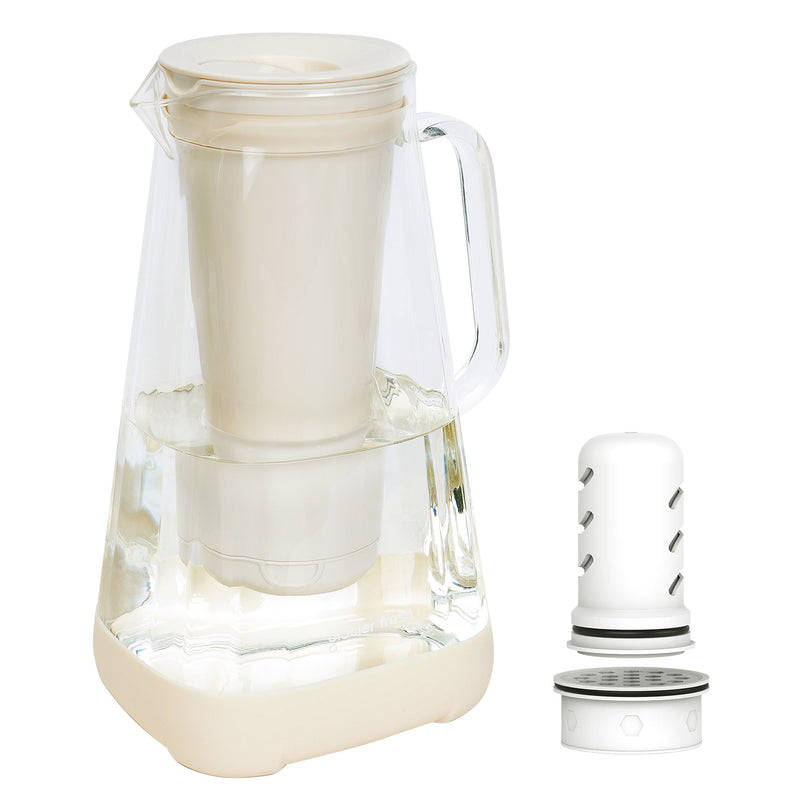Table of Contents:
Den Wasserbedarf beim Wandern verstehen
Die Wahl der richtigen Wasserfiltermethode
Gefiltertes Wasser für Fernwanderungen aufbewahren
Praktische Tipps zur Verwendung von gefiltertem Wasser auf dem Trail
Umgang mit Wasserfilterproblemen auf dem Trail
Umweltaspekte und „Leave no trace“-Prinzipien
Abschluss
Fernwandern ist ein aufregendes und anspruchsvolles Erlebnis, das sorgfältige Vorbereitung erfordert. Einer der wichtigsten Aspekte beim Wandern – insbesondere über mehrere Tage – ist die ausreichende Flüssigkeitszufuhr. Allerdings kann es schwierig sein, unterwegs sauberes und sicheres Trinkwasser zu finden. Daher ist es für Ihre Sicherheit und Ihr Wohlbefinden unerlässlich, zu wissen, wie Sie gefiltertes Wasser zubereiten und aufbewahren.
In diesem Blog erfahren Sie alles Wissenswerte zum Filtern, Aufbereiten und Aufbewahren von Wasser für lange Wanderungen. Von der Wahl der besten Filtermethode bis hin zur Gewährleistung der Sicherheit und Zugänglichkeit Ihres Wassers – wir haben alles für Sie!
Den Wasserbedarf beim Wandern verstehen
Wie viel Wasser brauchen Sie?
Bei langen Wanderungen ist ausreichende Flüssigkeitszufuhr unerlässlich, um Energie zu tanken und Dehydrierung zu vermeiden. Als Faustregel gilt, je nach Wetterlage täglich etwa 2–3 Liter Wasser zu trinken. Bei Hitze oder starker Anstrengung benötigt Ihr Körper mehr Wasser. Berücksichtigen Sie bei der Planung Ihrer Wassermenge folgende Faktoren:
- Gelände : Steile Anstiege, zerklüftete Landschaften und große Höhen können den Wasserverlust durch Schwitzen erhöhen.
- Temperatur : Bei heißem Wetter ist häufigeres Trinken erforderlich.
- Anstrengung : Je mehr körperliche Aktivität, desto mehr Flüssigkeit benötigen Sie.
Es ist wichtig, genügend Wasser mitzunehmen – insbesondere auf Abschnitten der Strecke, auf denen es kaum Wasserquellen gibt. Planen Sie im Voraus, indem Sie Ihre Route auf verfügbare Wasserquellen prüfen.
Planung von Wassernachfüllstellen
Die Recherche und Planung Ihrer Wassernachschubstellen ist entscheidend für den Erfolg Ihrer Wanderung. Stellen Sie fest, wo es Wasserquellen gibt und ob Sie das Wasser sicher filtern oder reinigen können. In Gebieten, in denen Wasser schwer zu finden ist, müssen Sie zusätzliches Wasser mitnehmen oder sich bei anderen Wanderern oder in nahegelegenen Städten um Nachschub kümmern.
Die Wahl der richtigen Wasserfiltermethode
Arten von Wasserfiltersystemen
Beim Wandern ist unbehandeltes Wasser nicht unbedingt erforderlich, da es schädliche Bakterien, Parasiten oder Viren enthalten kann. Es gibt verschiedene Möglichkeiten, Wasser zu filtern, jede mit Vor- und Nachteilen.
- Tragbare Wasserfilter : Diese gibt es als Pumpen-, Quetsch- oder Schwerkraftwasserfilter . Sie filtern Bakterien und größere Verunreinigungen physisch heraus.
-
- Pumpenfilter: Wirksam für größere Gruppen, kann aber langsamer sein.
- Quetschfilter: Schnell und leicht, ideal für Alleinwanderer.
- Schwerkraftfilter: Ideal für Gruppen, da sie das Filtern von Wasser ohne manuellen Aufwand ermöglichen.
- UV-Reiniger : UV-Lichtreiniger wie der SteriPEN töten Bakterien, Viren und Protozoen ab, indem sie deren DNA deaktivieren. Sie sind leicht und einfach zu bedienen, benötigen aber Batterien oder eine wiederaufladbare Stromquelle.
- Chemische Behandlungen : Jod- oder Chlortabletten sind erschwinglich und leicht, erfordern aber längere Wartezeiten (30–60 Minuten), um ihre volle Wirksamkeit zu entfalten.
Auswahl des richtigen Filtersystems für Ihre Wanderung
Welches Filtersystem Sie wählen, hängt von der Art der Wanderung, der Gruppengröße und Ihren persönlichen Vorlieben ab. Hier sind einige Überlegungen, die Ihnen bei der Entscheidung helfen:
- Gewicht : Wenn Sie alleine wandern, ist ein Quetschfilter oder ein UV-Reiniger möglicherweise die beste Option, um Ihr Gepäck leicht zu halten.
- Benutzerfreundlichkeit : Ein Schwerkraftfilter oder eine Pumpe kann für Gruppenwanderungen effizienter sein.
- Qualität der Wasserquelle : Wenn Sie durch Gebiete mit schlechter Wasserqualität wandern, sollten Sie ein robustes Filtersystem in Betracht ziehen, beispielsweise einen Pumpenfilter oder einen UV-Reiniger.
Gefiltertes Wasser für Fernwanderungen aufbewahren
Die Wahl der richtigen Lagerbehälter
Sobald Ihr Wasser gefiltert ist, ist es wichtig, es sicher aufzubewahren. Die besten Aufbewahrungsbehälter für lange Wanderungen sind:
- Isolierte Wasserflaschen : Diese halten das Wasser kühl und sind robust genug für unwegsames Gelände.
- Trinkblasen : Praktisch für freihändiges Trinken, ideal für Wanderungen, bei denen Sie in Bewegung bleiben müssen.
- Faltbare Wasserflaschen : Ideal zum Platzsparen, wenn in Ihrem Rucksack wenig Platz ist.
Berücksichtigen Sie bei der Auswahl eines Vorratsbehälters die Gesamtmenge an Wasser, die Sie mitführen müssen, und die einfache Zugänglichkeit. Insbesondere in abgelegenen Gebieten sollte das Fassungsvermögen für die Flüssigkeitsversorgung über mehrere Tage ausreichen.
Wasser kühl und sicher halten
Wenn Sie bei heißem Wetter wandern, können isolierte Flaschen oder Trinkrucksäcke helfen, Ihr Wasser den ganzen Tag über kühl zu halten. Bewahren Sie Ihr Wasser bei Wanderungen bei kaltem Wetter in einer isolierten Flasche oder in Ihren Kleidungsschichten auf, um ein Gefrieren zu verhindern.
Stellen Sie immer sicher, dass Ihre Vorratsbehälter sauber sind, bevor Sie gefiltertes Wasser lagern. Verunreinigte Flaschen können die Funktion Ihres Filtersystems schnell zunichtemachen.
Wasser für einfachen Zugriff organisieren
Eine effiziente Wasserspeicherung ist für den Komfort unerlässlich. Hier einige Tipps:
- Tragen Sie zwei Flaschen bei sich : eine für den sofortigen Gebrauch und eine als Reserve.
- Verwenden Sie einen Trinkrucksack, um unterwegs bequem trinken zu können.
- Beschriften Sie Ihre Behälter : So vermeiden Sie Verwechslungen zwischen gefiltertem Wasser und anderen Flüssigkeiten wie Elektrolytgetränken oder ungefiltertem Wasser.
Praktische Tipps zur Verwendung von gefiltertem Wasser auf dem Trail

Zunächst einmal sollte die richtige Flüssigkeitszufuhr oberste Priorität haben. Trinken Sie regelmäßig, auch wenn Sie keinen Durst haben. Eine gute Faustregel ist, mindestens einen halben Liter pro Stunde zu trinken. Aber übertreiben Sie es nicht; Wasservergiftungen sind durchaus möglich!
Denken Sie auch daran, wie wichtig die Filterwartung ist. Ihr tragbares Filtergerät nützt Ihnen nicht viel, wenn es verstopft oder beschädigt ist. Reinigen Sie es regelmäßig gemäß den Anweisungen des Herstellers und haben Sie immer einen Ersatzfilter im Rucksack.
Gehen Sie immer davon aus, dass Wasserquellen für die Sicherheit auf dem Weg unbedenklich sind, auch wenn sie sauber aussehen. Filtern, kochen oder behandeln Sie Ihr Wasser vor dem Trinken. Fließendes Wasser aus Bächen oder Flüssen ist in der Regel sicherer als stilles Wasser, muss aber dennoch behandelt werden.
Denken Sie schließlich daran, Ihren Wasservorrat aufzufüllen, wann immer Sie auf eine zuverlässige Quelle stoßen. Bäche, Quellen und Seen können lebensrettend sein, aber denken Sie daran, dass sie nicht unbegrenzt verfügbar sind.
Umgang mit Wasserfilterproblemen auf dem Trail
Trotz sorgfältiger Planung kann die Wasserfilterung auf dem Weg einige Herausforderungen mit sich bringen. Bei einer längeren Wanderung ist die Identifizierung von Wasserquellen entscheidend. Sie können sich nicht nur auf die Wanderkarte verlassen, sondern müssen ständig nach potenziellen Wasserquellen Ausschau halten. Hier sind drei Punkte zum Umgang mit den Herausforderungen der Wasserfilterung auf dem Weg:
- Wartung des Filtersystems : Ihr Wasserfilter ist Ihre Lebensader, funktioniert aber nur mit Sorgfalt lange. Regelmäßige Wartung sorgt für seine Wirksamkeit. Lernen Sie, Teile bei Bedarf auszutauschen und das System gründlich zu reinigen, um Verstopfungen zu vermeiden.
- Notfall-Backup-Optionen : Haben Sie immer einen Plan B. Das können Wasserreinigungstabletten oder ein kleiner Backup-Filter sein. Man weiß nie, wann das Hauptsystem ausfallen könnte.
- Trinkstrategien : Warten Sie nicht, bis Sie Durst verspüren, sondern trinken Sie regelmäßig kleine Schlucke Wasser, um ausreichend Flüssigkeit zu erhalten. Trinken Sie aber auch nicht zu viel, da dies Ihren Wasservorrat schnell aufbrauchen kann.
Umweltaspekte und „Leave no trace“-Prinzipien
Verwenden Sie beim Filtern von Wasser eine saubere Quelle und vermeiden Sie die Verschmutzung von Gewässern . Denken Sie bei Ihren Bemühungen, Abfall zu reduzieren, daran, dass jedes Bisschen zählt. Packen Sie ein und packen Sie aus. Hinterlassen Sie keine Spuren Ihrer Wasserfilterbemühungen, einschließlich Rückstände von Wasserreinigungstabletten oder Filtern. Ein Bewusstsein für Wildtiere ist entscheidend. Menschliche Aktivitäten können Tiere beeinträchtigen, seien Sie also achtsam. Stören Sie Wildtiere und deren Lebensräume nicht, während Sie Wasser holen oder filtern.
Die Wanderetikette geht Hand in Hand mit diesen Grundsätzen. Respektieren Sie die Erfahrungen anderer Wanderer und bewahren Sie die Ruhe der Natur. Zusammenfassend sind hier einige wichtige Punkte:
- Priorisieren Sie nachhaltige Praktiken und den Schutz des Ökosystems.
- Bemühen Sie sich, Abfall zu reduzieren und sicherzustellen, dass keine Spuren hinterlassen werden.
- Behalten Sie das Bewusstsein für die Tierwelt und halten Sie die Verhaltensregeln auf den Wanderwegen ein.
Abschluss
Ausreichende Flüssigkeitszufuhr ist der Schlüssel zu einer erfolgreichen und angenehmen Langstreckenwanderung. Mit Planung, der Wahl des richtigen Wasserfiltersystems und der sicheren Lagerung und Verfügbarkeit Ihres Wassers sind Sie für jede Wanderung bestens gerüstet – egal wie lang sie ist. Trinken Sie regelmäßig, pflegen Sie Ihren Filter und achten Sie auf Ihre Umweltauswirkungen. Mit diesen Tipps bleiben Sie auf Ihrem Abenteuer sicher, gesund und hydriert! Folgen Sie Glacier Fresh, um weitere Wasserfilterlösungen zu entdecken.


















